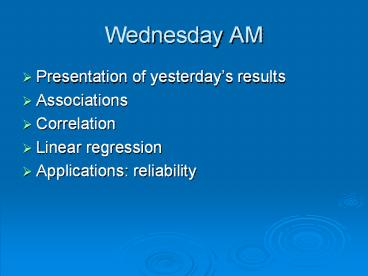Wednesday AM - PowerPoint PPT Presentation
Title:
Wednesday AM
Description:
Wednesday AM Presentation of yesterday s results Associations Correlation Linear regression Applications: reliability – PowerPoint PPT presentation
Number of Views:71
Avg rating:3.0/5.0
Title: Wednesday AM
1
Wednesday AM
- Presentation of yesterdays results
- Associations
- Correlation
- Linear regression
- Applications reliability
2
Associations
- Were often interested in the association between
two variables, especially two interval scales. - Associations are measured by their
- direction (positive, negative, u-shaped, etc.)
- magnitude (how well can you predict one variable
by knowing the score on the other?)
3
Correlation
- The (Pearson) correlation (r) between two
variables is the most common measure of
association - Varies from -1 to 1
- Sign represents direction
- r2 is the proportion of variance in common
between the two variables (how much one can
account for in the other) - Relationship is assumed to be linear
4
Correlation in SPSS
- AnalyzeCorrelateBivariate
- Enter variables to be correlated with one other.
- Q1 Q2 Q3
- Q1 Pearson Correlation 1.000 .105 .109
- Sig. (2-tailed) . .111 .099
- N 233 233 231
- Q2 Pearson Correlation .105 1.000 .616
- Sig. (2-tailed) .111 . .000
- N 233 234 232
- Q3 Pearson Correlation .109 .616 1.000
- Sig. (2-tailed) .099 .000 .
- N 231 232 232
- There was a significant positive correlation
between Q2 and Q3 (r 0.62, p lt .05).
5
Linear regression
- Correlation is a measure of association based on
a linear fit. - Linear regression provides the equation for the
line itself (e.g. Y b1X b0) - That is, in addition to providing a correlation,
it tells how much change in the independent
variable is produced by a given change in the
dependent variable... - ... in both natural units and standardized units.
6
Linear regression in SPSS
- AnalyzeRegressionLinear
- Enter dependent and independent variables
- Three parts to output
- Model summary how well did the line fit?
- ANOVA table did the line fit better than a null
model? - Regression equation what is the line? How much
change in the dependent variable do you get from
a 1 unit (or 1 standard deviation) change in the
independent variable
7
Linear regression output
- Predicting Q2 from Q3
- Model Summary
- R R Square Adjusted R Square
- .616 .380 .377
- R is the correlation
- R2, the squared correlation, is proportion of
variance in Q2 accounted for by variance in Q3 - Adjusted R2 is a less optimistic estimate
8
Linear regression output
- ANOVA
- Sum of Sq df Mean Square F Sig.
- Regression 153.924 1 153.924 140.8 .000
- Residual 251.455 230 1.093
- Total 405.379 231
- Shows that the regression equation accounts for a
significant amount of the variance in the
dependent variable compared to a null model. - (A null model is a model that says that the mean
of Q2 is the predicted Q2 for all subjects).
9
Linear regression ouput
- Coefficients
- Unstandardized Standardized
- B Std. Error Beta t Sig
- (Constant) .804 .315 2.554 .011
- Q3 .693 .058 .616 11.866 .000
- Unstandardized coefficients (B) give the actual
equation - Q2 0.693 Q3 0.804
- These are raw units. An increase of 1 point in Q3
increases Q2 by 0.693 points on average. People
who have Q3 0 have Q2 0.804 on average, etc. - Because SE of B is estimated, we can perform
t-tests to see if a B is significantly different
than 0 (has a significant effect). - Standardized coefficients (?) give the amount of
change in Q2 caused by a change in Q3, measured
in standard deviation units. They are useful in
multiple regression (later)...
10
Measuring reliability of a scale
- Test-retest reliability is usually measured as
the correlation between tests (ranks of subjects
stay the same at each testing) - Cronbachs ? is another common internal
reliability measure based on the average
inter-item correlation of items in a scale.
11
Cronbachs ? in SPSS
- AnalyzeScale...Reliability analysis
- Enter item variables that make up the scale
- Go to Statistics dialog box and ask for scale and
scale if item deleted descriptives.
12
Cronbachs ? in SPSS
- Item-total Statistics
- Scale Scale Corrected
- Mean Variance Item- Alpha
- if Item if Item Total if Item
- Deleted Deleted Correlation Deleted
- Q1 21.2913 9.2466 .3133 .6071
- Q2 23.4000 6.0576 .4507 .5325
- Q3 22.5826 6.4975 .4798 .5096
- Q4 21.9043 8.5148 .3565 .5840
- Q5 22.2130 7.4173 .3448 .5870
- Reliability Coefficients
- N of Cases 230.0 N of
Items 5 - Alpha .6229 Standardized item alpha .6367
13
Wednesday AM assignment
- Using the clerksp data set
- Examine the correlations between items 1-17
(self-ratings of different clerkship skills).
What do you notice about the correlation matrix? - Select any one of those 17 items. Run a linear
regression to determine if the pre-clerkship
rating on that item predicts the post-clerkship
rating. - Assume that we want to combine post-clerkship
items 1-17 into a single scale of self-related
clerk skill. What would the reliability of this
scale be?










![❤[PDF]⚡ The New York Times Wednesday Crossword Puzzles Volume 1: 50 Not-Too-Easy, PowerPoint PPT Presentation](https://s3.amazonaws.com/images.powershow.com/10071896.th0.jpg?_=20240704011)














![[PDF] READ Free The New York Times Wednesday Crossword Puzzles Volume PowerPoint PPT Presentation](https://s3.amazonaws.com/images.powershow.com/10103901.th0.jpg?_=20240821052)





